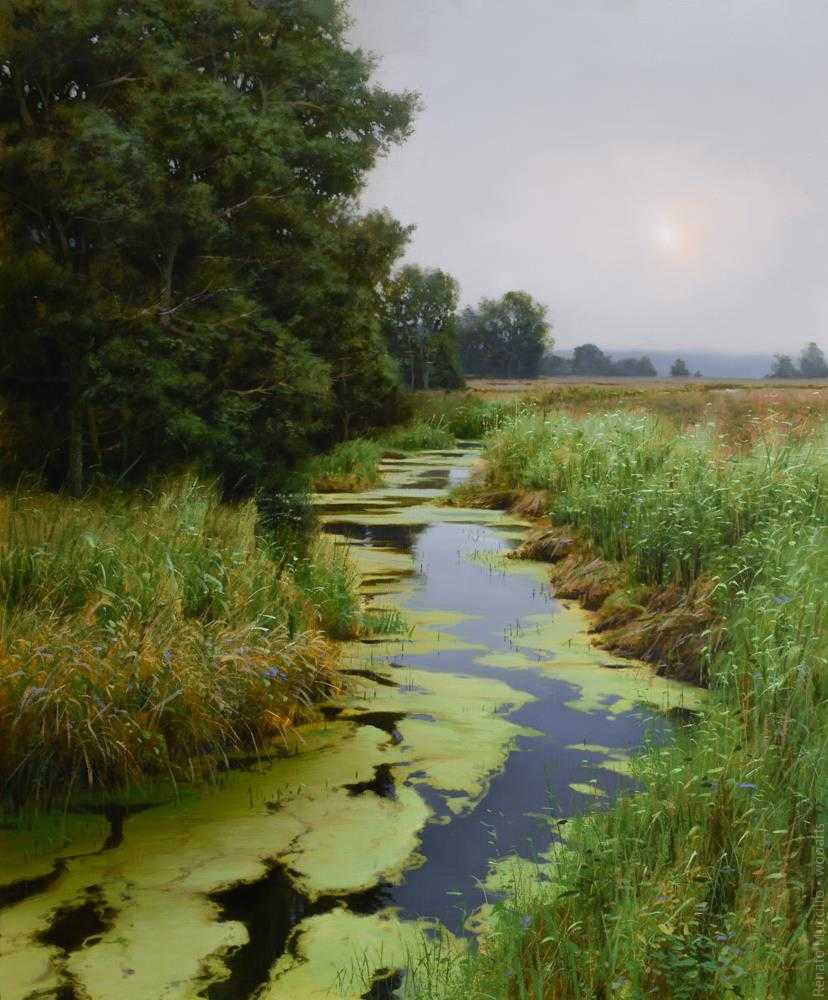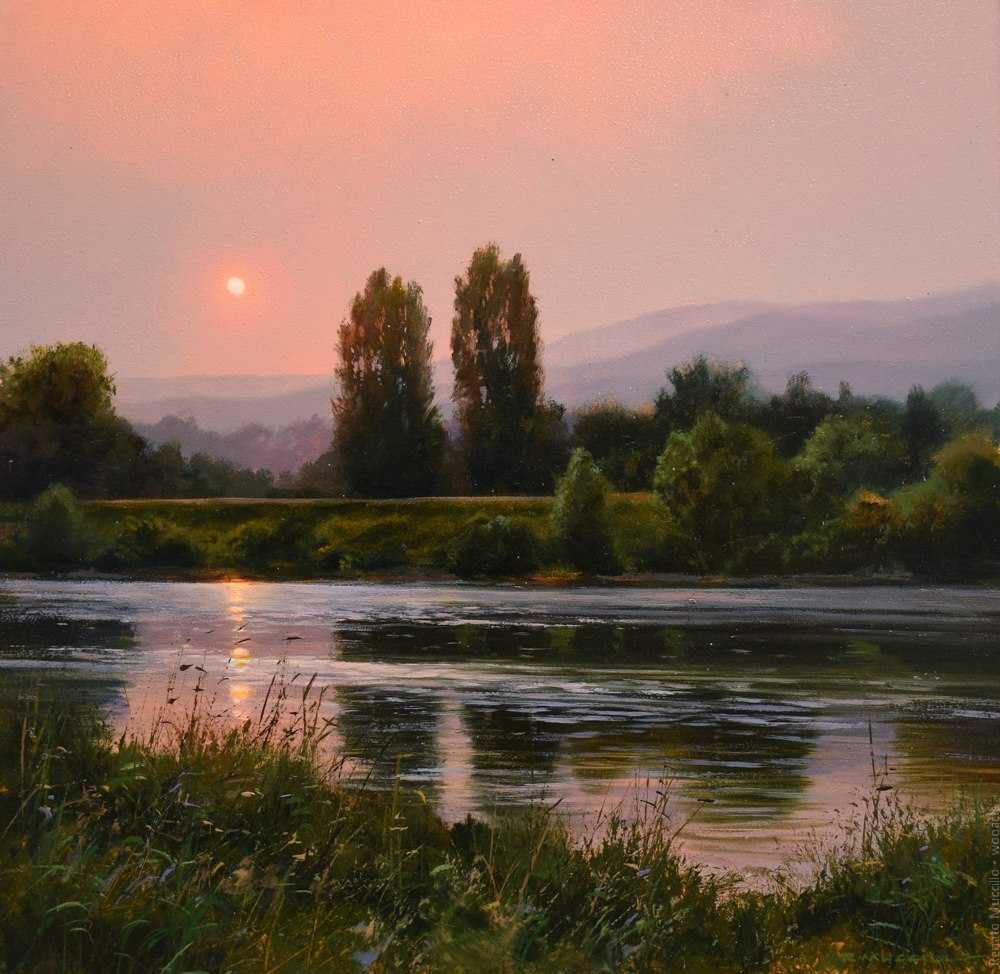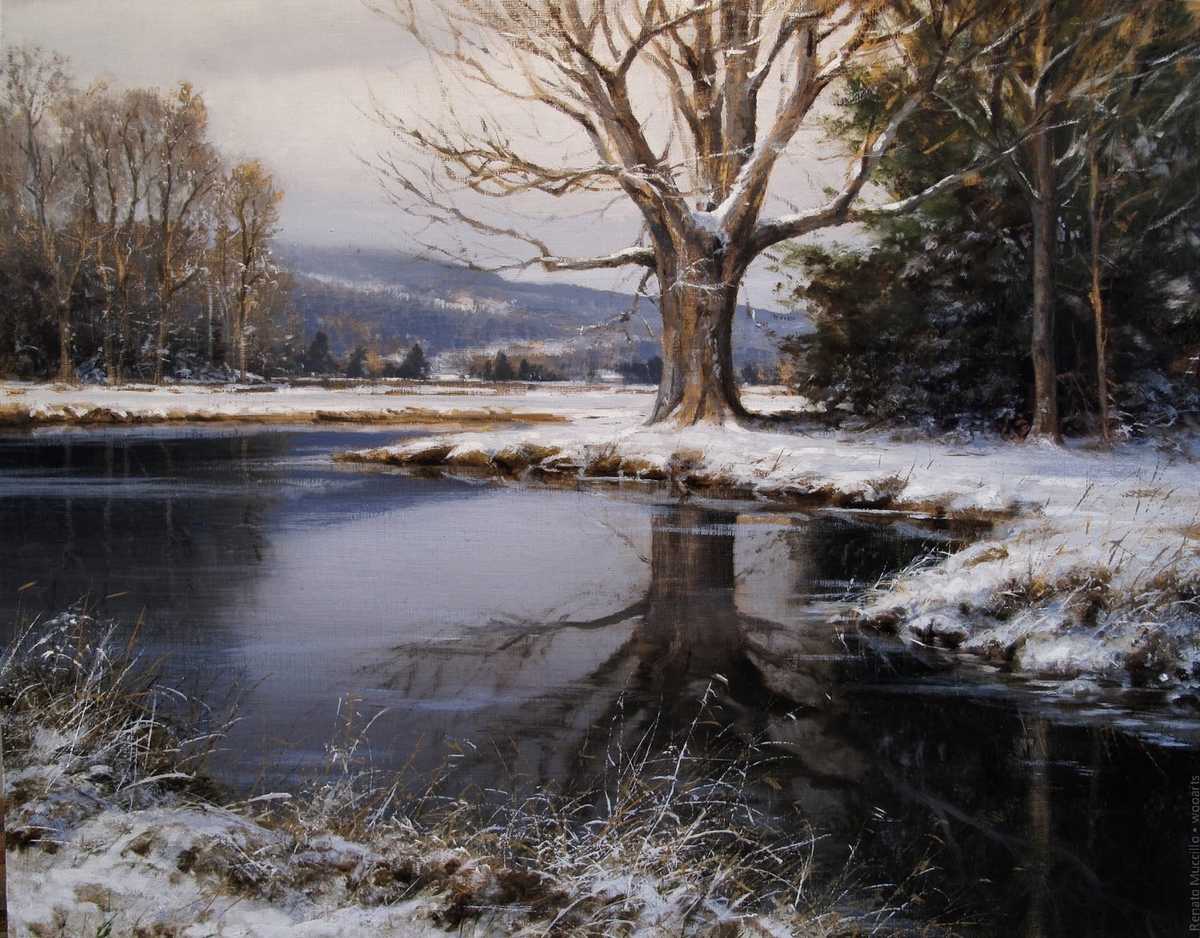Renato Muccillo Painting
It was a morning in early autumn a year ago, and, as usual, Renato Muccillo was out strolling in the area. With him was his “studio buddy for the last eight years,” his greyhound, Ajax. “He likes to peel around on the dikes,” Muccillo says. “So he’s one of the driving factors for me to get out there.”
It was a morning in early autumn a year ago, and, as usual, Renato Muccillo was out strolling in the area. With him was his “studio buddy for the last eight years,” his greyhound, Ajax. “He likes to peel around on the dikes,” Muccillo says. “So he’s one of the driving factors for me to get out there.”
Suddenly, Muccillo was struck by the feeling that he was “the only person on the planet.” The saturated natural palette all around him—the gold of native grasses, the blues and grays of sky and water, the greens of the hillsides and of the algae that fringed the water—deepened his sense of glorious isolation. He took out his BlackBerry and snapped numerous random reference shots in what he calls “an exercise in memorization, to capture the mood and sense of place.”

Then, back in his 300-square-foot studio—which adjoins the Craftsman-style cedar home he built himself in the nearby town of Maple Ridge—he began to transform those impressions into a painting he eventually entitled SANCTUARY. Downloading the photos to his laptop, he combined “bits of this, bits of that,” until he achieved a concept that captured not so much the physical reality of what he had seen as the emotional impact it had on him.
That done, he began to paint directly on a 36-by-36-inch canvas of double-oil-primed linen, without so much as the barest sketch to block out the work beforehand. “As soon as pencil or charcoal goes down,” he says, “I feel it’s very restrictive. I lose the painting’s fluidity.”

Landscapes of the Heart Heavy, brooding skies hung low over the Grant Narrows, a corner of the agricultural Fraser Valley some 25 miles east-northeast of downtown Vancouver, British Columbia. Storm clouds wreathed the nearby hills in wisps of white. Winds whipped the air. Yet, remarkably, the irrigation channels that crisscross the land and provide sanctuary to sandhill cranes and blue herons remained tranquil, sheltered by the tall earthen dike walls that control the waters of the nearby Pitt and Alouette rivers.

It was a morning in early autumn a year ago, and, as usual, Renato Muccillo was out strolling in the area. With him was his “studio buddy for the last eight years,” his greyhound, Ajax. “He likes to peel around on the dikes,” Muccillo says. “So he’s one of the driving factors for me to get out there.”

Suddenly, Muccillo was struck by the feeling that he was “the only person on the planet.” The saturated natural palette all around him—the gold of native grasses, the blues and grays of sky and water, the greens of the hillsides and of the algae that fringed the water—deepened his sense of glorious isolation. He took out his BlackBerry and snapped numerous random reference shots in what he calls “an exercise in memorization, to capture the mood and sense of place.”

Then, back in his 300-square-foot studio—which adjoins the Craftsman-style cedar home he built himself in the nearby town of Maple Ridge—he began to transform those impressions into a painting he eventually entitled SANCTUARY. Downloading the photos to his laptop, he combined “bits of this, bits of that,” until he achieved a concept that captured not so much the physical reality of what he had seen as the emotional impact it had on him.

That done, he began to paint directly on a 36-by-36-inch canvas of double-oil-primed linen, without so much as the barest sketch to block out the work beforehand. “As soon as pencil or charcoal goes down,” he says, “I feel it’s very restrictive. I lose the painting’s fluidity.”

Fluidity is essential. As he does for all his paintings, Muccillo began with “one big monochromatic wash of color, moving paint over paint, rubbing back, and forming imagery in that base—primarily with a brush but also rags, Q-tips, or anything to aid in making marks. It’s all very primal.”

This process produces what he describes as “a very basic composition,” but it also serves to harmonize all the colors that follow. And it endowed the painting with a mood that prevailed as, over the course of weeks, the artist continued painstakingly to build up his final image with at least 10 thin layers of oil glaze, sometimes deepening the water or sky, sometimes suggesting an entire field through just a few carefully portrayed and strategically placed blades of grass.

The results of this process, which he follows on as many as 20 canvases he may be working on at any given time, are meditative, moving, minimalist landscapes in a style that the artist describes at first as “a deeply controlled impressionism.” Then, resisting pat labels, he goes on to term his work variously as tonalist, acknowledging late-19th-century American painters like George Inness; luminist, first applied in the 20th century to the nature scenes of 19th-century American painters like Albert Bierstadt and Frederic Church; and the broader traditionalist and classicist, acknowledging that he paints largely realistic images that serious collectors have long found desirable.

As that hard-to-pin-down checklist of styles may suggest, Renato Muccillo stands resolutely apart from art-world conventions. From the earliest manifestations of his talent to the present day, he has blazed his own unconventional trail.

Muccillo was born in Vancouver in 1965 to immigrant parents from Campobasso, a small, 13-centuries-old city in southern Italy’s Apennine Mountains. “To understand my father and mother,” says Muccillo, “gives a little insight to why I am the way I am as an artist.” He describes the couple, now in their 80s and still thriving, as “salt of the earth, and their key drive in life is survival.”

To this day, his dad, a retired cement mason, and his mother, a homemaker, remain “hard-core gardeners,” and his mother still cans the bounty from the expertly tended patch behind their East Vancouver home. In addition, his father has always loved to fish, and he still hunts pheasants every autumn.

So, from an early age, Muccillo was taught to “do things by hand, forge your own path.” And, though it sometimes bewildered his parents—who wondered how he could make a living at it—young Renato was “very, very driven to draw and paint.” He remembers rising early on Christmas morning, before the age of 5, to create drawings as presents for his family.

The one prize pheasant his dad kept each year from the hunt to have stuffed and mounted as a trophy, Renato would also depict in a colored-pencil sketch, “simply because my father loved [the pheasants].” On weekends, when the family headed out to the Fraser Valley to take their dogs on field runs in preparation for hunting season, Renato brought his paints and set up his easel amidst the grasses, creating imaginative landscapes not necessarily related to his surroundings. By the time he was 10, he was selling his paintings through a local art-supply store.

Yet, Muccillo never received—and didn’t seek out—any special art lessons to help hone his talent. Instead, he names his third-grade teacher, Rosemary Mack, as a critical influence, who simply accepted him for who he was: the “hyper-bouncy, usually distracted” boy who was forever drawing and coloring. “I felt she understood what I was doing, that this was my gift, and she was so caring and nurturing.”

Meanwhile, his parents encouraged him to seek a more practical trade he could rely upon. With a passion for cooking nurtured by his family’s dedication to self-sufficiency and gardening—“You ain’t Italian if you don’t love food,” he interjects with a laugh—Muccillo first set his sights on becoming a chef, working in local kitchens while still in his teens. Then, with even more practicality, straight out of high school he landed a clerical job at a local Bank of Montreal office, where he stayed for seven years.

All the while, he painted in his spare time. “I knew I wanted to be an artist,” he says. “I just didn’t know how to get there.” What eventually got him there was witnessing the rise of Canadian naturalist and wildlife artist Robert Bateman, whose realistic paintings, lithographs, and books had become phenomenal bestsellers by the mid-1980s. “I remember coming across his images, and stories about how financially successful he was, and thinking that I could do this.”

Still clerking at the bank, Muccillo began painting his own highly lifelike images of Canadian animals in the wild, starting with a close-up of a great horned owl. He then made quality photographic color prints of his paintings and started selling them to his coworkers and friends. Then, a loan officer at the bank introduced Muccillo to her son, who worked for an art-publishing company in Toronto. “‘We’ve got a lot of artists, but I’ll take a look,’” he remembers the man telling him. “Then I opened my portfolio. His eyes opened wide, and he said, ‘I think we can work together.’”

They did. Muccillo left the bank in 1993 and began producing around half a dozen “really tight, photorealistic” animal paintings a year, specifically designed for high-quality color lithographic reproduction. He might have continued doing that were it not for the rise of giclée prints, which offered superior art reproduction on a mass scale using digital scanning and large-format inkjet printers. “The market suddenly flooded,” he says, “and I found myself competing with hundreds and hundreds of artists.”

Frustrated, in 1996 he stopped painting and returned to a desk job, working in an administrative position at the Law Society of British Columbia. “It was a great job,” he recalls. “My life was set.” But Muccillo’s creative impulses couldn’t be suppressed. An art collection decorated the walls of the Law Society’s offices, and soon he’d been granted permission to add some of his own canvases to the display.

The style of his works began to change after he visited a late-1990s show at the Vancouver Art Gallery on the Group of Seven, a band of artists who revolutionized painting in Canada after World War I by portraying the nation’s landscapes in works that ranged from lyrical impressionism to vibrant, emotion-packed expressionism. Seeing these seminal works, says Muccillo, “set me free and made me look outside of what I was comfortable with. I went from über-realistic wildlife [paintings] to landscapes approached in a much more abstracted form. I wasn’t used to laying out a particular brush stroke and leaving it. Slowly, I whittled away things I didn’t need and honed my particular style to what it is now.”

By 2002, his landscapes were being shown—and selling—in group shows at the Federation of Canadian Artists and a local gallery. Solo exhibitions soon followed. Since 2003, Muccillo has been painting full time—and this time, with multiple awards and booming sales, there’s no turning back.

As he has throughout his life and his evolution as an artist, the 46-year-old Muccillo continues to be what he describes as “largely self-taught. I understand who I am as a person and what drives me. Especially with this artistic avenue, I don’t want to be influenced by any particular teacher. I want to intuit enough to learn myself what I need to know. This is my own independent journey through life, and I want to see how far I can go.” Southwest Art Magazine - February 2012 By Norman Kolpas

Apparitions of the Narrows Renato Muccillo, The Avenue Gallery, 2184 Oak Bay Ave., 250-598-2184, www.theavenuegallery.com, until May 23. Renato Muccillo reports that his mother told him "get a good job. Do cement, like your father!" To judge by the lineup that awaited the opening of his show at the Avenue Gallery, following his own path was a good idea.

Muccillo lives in Maple Ridge, 50 kilometres east of Vancouver: "My valley," as he calls it with pride. Nearby Pitt Meadows was once a big marsh, the floodplain of the Pitt River, but a century ago the Dutch diked it and drained it and left a rich agricultural bottomland. Muccillo loves to paint this compressed, flat landscape and the huge vaporous cloudscapes that rise above.

The exhibit gives ample evidence that Muccillo can draw like a wizard, yet his pleasure seems to be in simplification. "Detail is not necessary in developing a strong painting," he told an audience at the opening. He called his style "a very controlled impressionism." I call it the Dutch masters brought to a New World. His extreme sensitivity to atmospheric effects is translated through oil glazes tending toward warm golden tones reminiscent of the treasured canvases of Ruisdael or Cuyp. Never shy to add a few dots of colour, Muccillo sometimes dots in the lights of an industrial site in the distance to bring his vision up to date. By Robert Amos, Times Colonist, May 17, 2009 7:49 AM